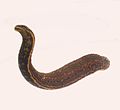Leech

Leeches are segmented worms that belong to the class Hirudinea in the phylum Annelida. They thrive in various environments, but most are associated with freshwater habitats. While they have a reputation for being bloodsuckers, not all leeches feed on the blood of other animals. Some are carnivorous, ingesting other invertebrates.
Anatomy and Physiology[edit]
Leeches are soft-bodied, segmented worms. They possess a sucker at both the anterior (front) and posterior (back) ends. The mouth is located in the anterior sucker. Most blood-feeding leeches secrete an anticoagulant, hirudin, which prevents the blood from clotting while the leech feeds.
Role in Medicine[edit]
The medicinal use of leeches, also known as hirudotherapy, dates back to ancient times and was prevalent until the 19th century. They were employed to remove blood from a patient as part of a procedure known as bloodletting, believed to balance the body's "humors."
In modern medicine, leeches have seen a resurgence in microsurgery and reconstructive surgery. Leeches help reduce blood coagulation and venous congestion by creating a continuous flow of blood from the wound area. They also release anti-coagulative and blood flow-enhancing substances into the wound.
Risks and Precautions[edit]
While leech therapy can be beneficial, it is not without risks. These include allergic reactions, infection from bacteria living in the leech's gut, and excessive bleeding. It is crucial that leech therapy is administered under the supervision of a trained medical professional.
Historical Use[edit]
The use of leeches in medicine has a long history, with depictions of leech use found in ancient Egyptian tombs and texts from ancient Greece. During the 19th century, leech use was so widespread that the European medicinal leech became endangered.
See also[edit]
Ad. Transform your life with W8MD's Budget GLP-1 injections from $75


W8MD offers a medical weight loss program to lose weight in Philadelphia. Our physician-supervised medical weight loss provides:
- Weight loss injections in NYC (generic and brand names):
- Zepbound / Mounjaro, Wegovy / Ozempic, Saxenda
- Most insurances accepted or discounted self-pay rates. We will obtain insurance prior authorizations if needed.
- Generic GLP1 weight loss injections from $75 for the starting dose.
- Also offer prescription weight loss medications including Phentermine, Qsymia, Diethylpropion, Contrave etc.
NYC weight loss doctor appointmentsNYC weight loss doctor appointments
Start your NYC weight loss journey today at our NYC medical weight loss and Philadelphia medical weight loss clinics.
- Call 718-946-5500 to lose weight in NYC or for medical weight loss in Philadelphia 215-676-2334.
- Tags:NYC medical weight loss, Philadelphia lose weight Zepbound NYC, Budget GLP1 weight loss injections, Wegovy Philadelphia, Wegovy NYC, Philadelphia medical weight loss, Brookly weight loss and Wegovy NYC
|
WikiMD's Wellness Encyclopedia |
| Let Food Be Thy Medicine Medicine Thy Food - Hippocrates |
Medical Disclaimer: WikiMD is not a substitute for professional medical advice. The information on WikiMD is provided as an information resource only, may be incorrect, outdated or misleading, and is not to be used or relied on for any diagnostic or treatment purposes. Please consult your health care provider before making any healthcare decisions or for guidance about a specific medical condition. WikiMD expressly disclaims responsibility, and shall have no liability, for any damages, loss, injury, or liability whatsoever suffered as a result of your reliance on the information contained in this site. By visiting this site you agree to the foregoing terms and conditions, which may from time to time be changed or supplemented by WikiMD. If you do not agree to the foregoing terms and conditions, you should not enter or use this site. See full disclaimer.
Credits:Most images are courtesy of Wikimedia commons, and templates, categories Wikipedia, licensed under CC BY SA or similar.
Translate this page: - East Asian
中文,
日本,
한국어,
South Asian
हिन्दी,
தமிழ்,
తెలుగు,
Urdu,
ಕನ್ನಡ,
Southeast Asian
Indonesian,
Vietnamese,
Thai,
မြန်မာဘာသာ,
বাংলা
European
español,
Deutsch,
français,
Greek,
português do Brasil,
polski,
română,
русский,
Nederlands,
norsk,
svenska,
suomi,
Italian
Middle Eastern & African
عربى,
Turkish,
Persian,
Hebrew,
Afrikaans,
isiZulu,
Kiswahili,
Other
Bulgarian,
Hungarian,
Czech,
Swedish,
മലയാളം,
मराठी,
ਪੰਜਾਬੀ,
ગુજરાતી,
Portuguese,
Ukrainian









